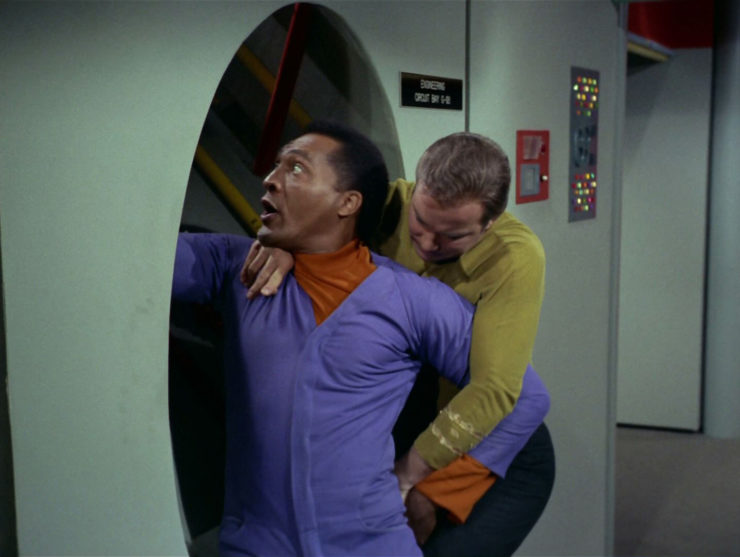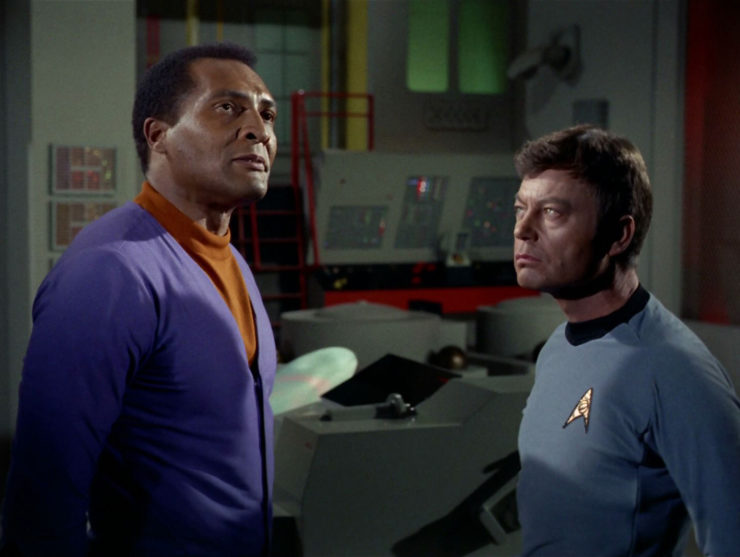In its first two episodes, Star Trek: Picard has subtly reminded us that the Daystrom Institute–the spot where a lot of rogue A.I. comes from–is also the most prestigious cybernetics research organization in the galaxy. Here’s why the history of the Daystrom Institute prior to Picard suggests that all these rogue A.I.s might not be an accident.
Spoilers ahead for the first two episodes of Star Trek: Picard. Speculation follows.
How Long Has The Daystrom Institute Been Making A.I.?
The name Daystrom Institute comes from the character Richard Daystrom (William Marshall) who appeared in the original series episode “The Ulitmate Computer.” At that point, in the year 2268, Daystrom is considered to be one of the best people working in the fields of computers and artificial intelligence. References to the Daystrom Institute pop-up throughout 24th century-era Star Trek, including The Next Generation, Deep Space Nine, and Voyager, suggesting the Institute may have been founded after Richard Daystrom’s death. But in the Discovery episode “Choose Your Pain,” Michael Burnham references the Daystrom Institute in the year 2256. This firmly establishes that the Institute existed while Daystrom was alive. Does that matter? It might. Let’s see.
How Many Daystrom A.I. Projects Have Gone Terribly Wrong?

Because there’s so little we know about the Synth Revolt in Star Trek: Picard or the origin of Control in Star Trek: Discovery, it’s possible the Daystrom Institute is responsible—directly or indirectly—for a lot of A.I. mayhem outside of what we’ve seen on screen. In terms of established canon, we know that two completely different kinds of A.I. — both originating at the Daystrom Institute — went bananas and killed a bunch of innocent humans.
The first rogue A.I. was the M-5 computer in “The Ultimate Computer.” After being hooked up to the Enterprise, the M-5 decided to start blowing-up other Federation starships. The cause here was chalked-up to the fact that the M-5 had been imprinted with Richard Daystrom’s actual personality engrams, and at the time he programmed the computer, he was suffering from a nervous breakdown. (This is like the worst possible outcome of using Siri or Alexa while you’re drunk.)
The second big Daystrom A.I. project that went wrong was the Synth Revolt on Mars in 2385, more than a hundred years after the M-5 went phaser-happy. As Dr. Jurati (Alison Pill) tells Jean-Luc in the very first episode of Picard, the synths who went rogue “came from this lab.”
Notably, Data, B-4, and Lore were not constructed by the Daystrom Institute. So the mixed success of those androids is a direct result of Noonian Soong and Juliana Soong (née O’Donnell) working privately on Omicron Theta. In the first two episodes of Picard, Jurati makes a big deal out of the fact that most of the Synths constructed at Daystrom had to be based on Data’s design. And F-8, the android who says “Hell yeah” and then kills a bunch of people on Mars, is a golden-skinned Soong-type android like Data. So, the Daystrom Institute borrowed the basic design of Data, and somehow created another A.I. that became murderous.
Is the Daystrom Institute Doing This On Purpose?

Okay. Theory time. Taken separately, the M-5 going ballistic and the Rogue Synths attacking Mars could be seen as isolated incidents. After all, Data broke bad a few times on TNG, and it wasn’t usually the fault of any prestigious Federation research facility. And yet, when the Daystrom Institute takes an active part in the plot of a Star Trek episode (as opposed to a passing reference) there’s almost always some kind of ethical murkiness going on. So, is the Daystrom Institute being puppeteered by Starfleet directly, or someone else? Let’s look at the evidence.
In Star Trek: The Next Generation’s episode “The Measure of a Man,” Bruce Maddox comes on board the Enterprise with orders from Starfleet to dismantle Data. This is not a purely scientific request, as Maddox is representing interests from higher up in Starfleet. (Sure, Starfleet’s mission is not one of conquest, but to quote David Marcus in The Wrath of Khan, “scientists have always been pawns of the military.”) This Institute isn’t just a tech school like MIT; it’s actually part of Starfleet on some level. In 2365, Bruce Maddox is a commander in Starfleet. He wears a Starfleet uniform, and he’s not just a visiting lecturer or something at Daystrom, he was the associate chair of robotics there, and when he came on the Enterprise to nab Data, he had a freaking Admiral backing him up.
Contrast this with other independent scientific research we see in other parts of Star Trek. In The Wrath of Khan, the Regula I lab is not part of Starfleet at all, and Carol Marcus specifically resists Starfleet interference. Ditto for Data’s creator, Dr. Noonian Soong, who, in the episode “Brothers,” is actually sort of pissed that Data is an officer saying, “Why Starfleet?” in a disappointed, gravelly voice that really just breaks Data’s little android heart. From Ira Graves to Dr. Reyga, there are plenty of other examples of scientists who don’t trust Starfleet in general, but you get the point. The Daystrom Institute is unique insofar as it plays ball with Starfleet directly. And the first two episodes of Picard prove that Maddox ended-up being 100-percent successful in carrying out Starfleet’s wishes: they did build an army of “disposable people” working, seemingly without freedom, on Mars.
So, if less-than-ethical parties in Starfleet got their way, then why — as I’m suggesting — would the Daystrom Institute have intentionally sabotaged the Synths?
Section 31 Could Be Creating False Flags as Part of a Covert A.I. Arms Race

Let’s assume for a moment that Section 31 is secretly pulling the strings at the Daystrom Institute AND that the basic design for Control in Star Trek: Discovery came from Daystrom himself. Why would anyone create A.I. that intentionally goes rogue? This question is central to Picard, because it’s relevant to the Romulan rescue armada. We know the Zhat Vash hate A.I., so it’s confusing as to why they would be the ones behind the Synth revolt on Mars since that would hurt the Romulans in the long run. But, assuming this is a mystery that Picard season 1 will solve before it’s over, there might be a deeper mystery wrapped inside all of that. Is Section 31 creating A.I. that goes rogue on purpose?
The events of season 2 of Discovery would make you think the answer to this question is no. Control literally takes over Section 31 and nearly destroys all of Starfleet in the process. But just a few years later the Daystrom Institute trots out the M-5, basically an analog version of Control that does the exact same thing, it seems like there’s a pattern here. If Section 31 was smart, they could be using the Daystrom Institute as a false flag to create renegade A.I.s on purpose. In the 2250s, they learned their lesson by explicitly linking Section 31 with Control, so, by the 24th century, perhaps Section 31 has decided to start farming out some of the renegade A.I.-building to Daystrom exclusively. Remember: Section 31 is part of Starfleet and so is the Daystrom Institute. If Section 31 thinks that an A.I. takeover of the Federation is a longterm threat in general, they could be intentionally creating aggressive A.I. for the purposes of banning the technology permanently.
Or, with the exact same actions, Section 31 could be ensuring the creation of opposing A.I. combatants that could fend off aggressive A.I. from other covert arms, like the Tal Shiar.
Essentially, we may be seeing the unfolding of an A.I. arms race.
Ryan Britt is a longtime contributor to Tor.com and the author of the book Luke Skywalker Can’t Read and Other Geeky Truths (Plume 2015.) His other writing and criticism have been published in Inverse, SyFy Wire, Vulture, Den of Geek!, the New York Times, and StarTrek.com. He is an editor at Fatherly. Ryan lives with his wife and daughter in Portland, Maine.










